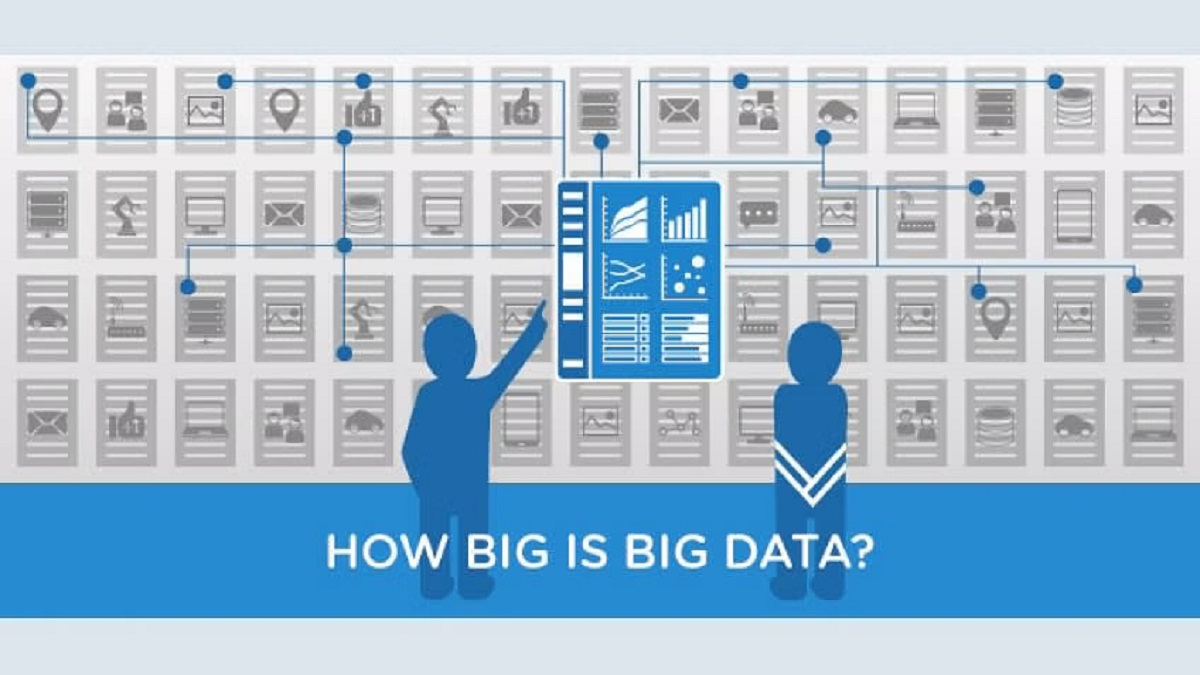Introduction
Big Data has revolutionized the way businesses operate, providing valuable insights and opportunities that were previously unimaginable. With the exponential growth of technology and the internet, companies are now able to collect, analyze, and interpret vast amounts of data to drive innovation and make informed decisions. This newfound ability to harness Big Data has resulted in significant advancements across various industries, ranging from customer experience improvement to risk management.
In today’s highly competitive business landscape, understanding how to effectively utilize Big Data can provide companies with a competitive edge. The sheer volume and complexity of data available enable businesses to gain valuable insights into customer behavior, market trends, and operational efficiency. By harnessing the power of Big Data, organizations can optimize processes, improve decision-making, and unlock new growth opportunities.
This article will delve into the ways Big Data is used in business and its impact on various aspects of operations. We will explore how Big Data can enhance customer experience, enable targeted marketing and advertising, identify trends and patterns, facilitate data-driven decision-making, improve fraud detection and security, optimize supply chain management, enhance operational efficiency, and bolster risk management strategies.
Improving Customer Experience
In today’s customer-centric world, providing an exceptional customer experience is paramount to the success of any business. By harnessing the power of Big Data, companies can gain valuable insights into customer preferences, behavior, and needs, allowing them to personalize their offerings and create a more tailored customer experience.
One way Big Data improves customer experience is through advanced analytics. By analyzing customer data such as browsing history, purchase patterns, and feedback, businesses can gain a deeper understanding of their customers’ preferences and interests. This data can then be used to create personalized recommendations, targeted promotions, and customized experiences that resonate with individual customers. For example, e-commerce platforms use Big Data analytics to offer personalized product recommendations based on a customer’s browsing or purchase history.
Another way Big Data improves customer experience is through sentiment analysis. By analyzing customer interactions, including social media posts, customer reviews, and call center conversations, businesses can gauge customer sentiment and identify areas for improvement. This allows companies to address customer concerns promptly, enhance their products or services, and ultimately deliver a better customer experience.
Furthermore, Big Data enables companies to understand the customer journey in greater detail. By analyzing data across multiple touchpoints, businesses can gain insights into the customer’s path to purchase, identify pain points, and streamline the buying process. For instance, analyzing website traffic data can highlight key pages or steps where customers drop off, enabling businesses to optimize these areas to enhance the overall customer experience.
Overall, leveraging the power of Big Data allows businesses to gain a deeper understanding of their customers and deliver personalized, seamless experiences. By tailoring their offerings to individual needs and preferences, companies can foster customer loyalty, drive customer satisfaction, and ultimately differentiate themselves in the market.
Targeted Marketing and Advertising
One of the most significant advantages of utilizing Big Data in business is the ability to target marketing and advertising efforts with precision. By analyzing vast amounts of customer data, businesses can develop targeted strategies that reach the right audience at the right time, resulting in higher conversions and improved return on investment.
Big Data analytics enables businesses to segment their customer base and understand their unique preferences, demographics, and behaviors. This segmentation allows companies to tailor their marketing messages and campaigns to specific audiences, increasing the relevance and effectiveness of their communications. For instance, a clothing retailer can use Big Data to target advertisements for winter jackets to customers in colder regions, while promoting swimwear to customers in beachside areas.
Furthermore, Big Data enables businesses to leverage real-time data to optimize their marketing efforts. By monitoring and analyzing customer behavior data in real-time, companies can identify trends, respond quickly to market changes, and adjust their marketing strategies accordingly. This level of agility and adaptability is essential in capturing and capitalizing on emerging opportunities. For example, an e-commerce platform can use real-time browsing data to trigger targeted email promotions or display ads for products that a customer has shown interest in.
In addition to targeting specific audiences and leveraging real-time data, Big Data can also help businesses measure the effectiveness of their marketing campaigns. By tracking key performance metrics such as click-through rates, conversion rates, and customer engagement, companies can assess the success of their marketing efforts and make data-driven improvements. This iterative approach allows businesses to optimize their marketing strategies and allocate resources more efficiently.
Overall, the integration of Big Data into marketing and advertising efforts enables businesses to reach the right audience with relevant messages, capitalize on real-time opportunities, and continuously improve marketing performance. By leveraging the power of data, companies can maximize their marketing investments and drive revenue growth.
Identifying Trends and Patterns
Big Data plays a crucial role in helping businesses identify and understand trends and patterns within their operations and the market at large. By analyzing large and diverse datasets, businesses can gain valuable insights into consumer behavior, market trends, and industry dynamics, enabling them to make informed decisions and stay ahead of the competition.
One way Big Data aids in identifying trends and patterns is through data mining and predictive analytics. By analyzing historical and real-time data, businesses can uncover hidden patterns and make predictions about future trends. For example, retailers can use Big Data to identify seasonal purchasing patterns, allowing them to stock inventory accordingly and optimize their supply chain management.
Furthermore, Big Data enables businesses to conduct market research at an unprecedented scale. Through sentiment analysis and social media monitoring, companies can gauge public opinion, track consumer preferences, and identify emerging trends. This information is invaluable in developing new products, refining marketing strategies, and staying attuned to the changing needs and desires of consumers.
In addition to understanding market trends, Big Data can also reveal patterns within an organization’s operations. By analyzing internal data, such as sales, production, and customer service data, businesses can identify bottlenecks, inefficiencies, and areas for improvement. This data-driven approach allows companies to streamline processes, optimize resource allocation, and enhance operational efficiency.
Another key aspect of identifying trends and patterns with Big Data is anomaly detection. By monitoring data for unusual patterns or outliers, businesses can quickly identify potential fraud, security breaches, or abnormalities within their systems. This proactive approach to detecting anomalies helps companies mitigate risks and safeguard their operations.
Overall, Big Data empowers businesses to leverage the wealth of information available to them and uncover trends, patterns, and insights that would be impossible to identify through traditional methods alone. By harnessing the power of data analysis, organizations can make data-driven decisions, adapt to changing market conditions, and stay ahead in a competitive landscape.
Making Data-Driven Decisions
Big Data has transformed the decision-making process for businesses by providing a wealth of information and insights to guide strategic choices. Organizations can leverage data analytics to make data-driven decisions, moving away from intuition and guesswork towards a more informed and proactive approach.
With the vast amount of data available, businesses can analyze trends, patterns, and correlations to inform their decision-making. Rather than relying solely on experience or gut feelings, data-driven decisions are based on factual evidence and analysis, leading to more accurate and reliable outcomes.
One of the primary benefits of making data-driven decisions is that they can be objective and unbiased. Data analysis eliminates personal biases and subjective factors from the decision-making process, ensuring that choices are based on facts and figures rather than personal preferences or individual opinions.
Furthermore, data-driven decision-making allows for better risk assessment and mitigation. By analyzing historical data and predictive analytics, businesses can identify potential risks and make proactive decisions to mitigate them. This proactive approach can help businesses avoid or minimize potential losses and make more informed choices in uncertain circumstances.
Another advantage of data-driven decision-making is the ability to measure and track the impact of decisions over time. By analyzing key performance metrics and tracking outcomes, businesses can evaluate the success of their decisions and make necessary adjustments if needed. This iterative process enables continuous improvement and optimization of business strategies.
In addition to enhancing decision-making, Big Data enables businesses to simulate and test scenarios before implementing strategies. By using historical data and predictive modeling, organizations can simulate various scenarios and assess the potential outcomes. This allows businesses to explore different options, evaluate risks, and determine the most effective course of action.
Overall, making data-driven decisions empowers businesses to leverage the power of Big Data to inform their choices, mitigate risks, and optimize outcomes. By embracing data-driven decision-making processes, organizations can improve decision accuracy, objectivity, and ultimately, drive better business performance.
Fraud Detection and Security
Big Data plays a critical role in protecting businesses from fraudulent activities and enhancing overall security measures. With the increasing prevalence of cyber threats and sophisticated fraud schemes, leveraging the power of Big Data allows businesses to detect anomalies, identify potential risks, and safeguard their operations.
One of the primary ways Big Data aids in fraud detection is through anomaly detection and pattern recognition. By analyzing vast amounts of data in real-time, businesses can identify unusual patterns or deviations from normal behavior. This can help detect fraudulent activities such as unauthorized financial transactions, identity theft, or unusual access to secure systems.
Additionally, Big Data enables businesses to create advanced risk models and predictive analytics algorithms. By combining historical data, machine learning techniques, and real-time monitoring, companies can assess the probability of fraudulent activities and act proactively to prevent them. This proactive approach can save businesses significant financial losses and reputational damage.
Furthermore, Big Data allows for the integration of different data sources, including internal data, external data, and third-party data. By consolidating and analyzing these diverse datasets, businesses can gain a comprehensive view of potential risks and detect fraudulent patterns that would be challenging to identify when examining isolated data sources.
In addition to fraud detection, Big Data can enhance overall cybersecurity measures. By analyzing network traffic, log files, and user behavior, businesses can identify potential vulnerabilities and detect malicious activities. This allows organizations to take immediate action to mitigate cyber threats, prevent data breaches, and protect sensitive information.
Moreover, Big Data can be utilized to create robust identity and access management systems. By analyzing user behavior patterns and multiple data points, businesses can ensure that only authorized individuals have access to critical systems and data. This helps prevent unauthorized access and protects digital assets from internal and external threats.
Overall, leveraging the power of Big Data in fraud detection and security measures allows businesses to proactively identify and mitigate risks, protect sensitive information, and maintain the trust of customers and stakeholders. By harnessing the capabilities of data analytics and real-time monitoring, organizations can stay one step ahead of fraudsters and ensure the integrity and security of their operations.
Supply Chain Optimization
Supply chain optimization is a critical aspect of business operations, and Big Data has revolutionized the way companies manage and optimize their supply chains. By harnessing the power of data analytics, businesses can gain valuable insights into their supply chain processes, make informed decisions, and drive efficiency and cost savings.
One way Big Data contributes to supply chain optimization is through demand forecasting. By analyzing historical sales data, market trends, and external factors, businesses can accurately predict customer demand and adjust their production and inventory levels accordingly. This helps prevent stockouts or excess inventory, minimizing costs and improving customer satisfaction.
Furthermore, Big Data enables businesses to enhance supply chain visibility and traceability. By collecting data throughout the supply chain, from raw materials sourcing to product delivery, companies can have real-time insights into the entire process. This transparency allows for better coordination, risk management, and the identification of bottlenecks or inefficiencies that can be addressed promptly.
In addition to visibility, Big Data facilitates supply chain collaboration and optimization. By sharing data with suppliers, manufacturers, and logistics partners, businesses can streamline processes, reduce lead times, and improve overall efficiency. For example, sharing production data with suppliers can help them align their production schedules with demand, reducing delays and improving supply chain performance.
Moreover, leveraging Big Data analytics can enable predictive maintenance and equipment optimization. By monitoring data from machines and equipment, businesses can detect potential issues before they lead to breakdowns. This proactive approach allows for planned maintenance, minimizing unplanned downtime and reducing costs associated with equipment failures.
Additionally, Big Data analytics can optimize logistics and transportation operations. By analyzing data such as shipping routes, delivery times, and fuel consumption, businesses can identify inefficiencies and explore alternative transportation methods. This can result in cost savings, improved delivery times, and reduced environmental impact.
Overall, the integration of Big Data into supply chain management enables businesses to optimize their processes, improve visibility and collaboration, and drive cost savings. By leveraging data analytics, companies can proactively manage demand, enhance coordination, and make data-driven decisions that lead to a more efficient and effective supply chain.
Operational Efficiency
Operational efficiency is a key focus for businesses looking to streamline processes, reduce costs, and improve overall productivity. Big Data has emerged as a powerful tool to help organizations optimize their operations and achieve higher levels of efficiency.
One of the primary ways Big Data contributes to operational efficiency is through process optimization. By analyzing data across various stages of operations, businesses can identify bottlenecks, inefficiencies, and areas for improvement. This data-driven approach allows companies to streamline workflows, eliminate redundant steps, and improve overall productivity.
Furthermore, Big Data enables businesses to implement predictive maintenance strategies. By analyzing sensor data and machine performance metrics, companies can detect potential equipment failures and proactively schedule maintenance or repairs. This proactive approach helps minimize unplanned downtime, reduce maintenance costs, and optimize asset utilization.
In addition to process optimization and predictive maintenance, Big Data facilitates real-time monitoring and alert systems. By collecting and analyzing data from various sources, such as sensors, IoT devices, and operational systems, businesses can gain real-time insights into their operations. This real-time visibility allows for prompt detection of issues and the ability to take immediate action, minimizing disruptions and improving overall efficiency.
Moreover, Big Data analytics can improve inventory management and supply chain operations. By analyzing sales data, customer trends, and market forecasts, businesses can optimize inventory levels, reduce stockouts or excess inventory, and improve inventory turnover. This leads to cost savings and better customer satisfaction due to improved product availability.
Additionally, Big Data enhances workforce optimization by analyzing employee performance data, identifying areas for skills development, and streamlining workforce allocation. By leveraging data analytics, companies can better align resources with demand, reduce labor costs, and optimize workforce productivity.
Overall, the integration of Big Data analytics into operations enables businesses to improve efficiency, reduce costs, and drive productivity. By leveraging the power of data, organizations can identify and address operational bottlenecks, implement proactive maintenance strategies, improve supply chain operations, enhance real-time monitoring, and optimize workforce allocation. These data-driven approaches contribute to improved operational efficiency and ultimately lead to a competitive advantage in the market.
Risk Management
Risk management is a critical aspect of business operations, and Big Data plays a significant role in helping businesses identify, assess, and mitigate risks. By leveraging the power of data analytics, companies can gain valuable insights into potential risks, improve risk assessment models, and make proactive decisions to safeguard their operations.
One way Big Data aids in risk management is through the analysis of historical and real-time data to identify patterns and trends. By analyzing large datasets, businesses can detect anomalies and potential risks. This enables companies to take proactive measures to mitigate those risks, minimizing potential losses and damages.
Furthermore, Big Data analytics allows for improved risk assessment and predictive modeling. By integrating various data sources, including internal data, external data, and third-party data, companies can assess the probability and impact of potential risks. This information empowers businesses to make strategic decisions and allocate resources effectively to manage risks.
In addition to assessing risks, Big Data enables businesses to enhance fraud detection and security measures. By analyzing data across multiple touchpoints, businesses can identify potential fraud patterns, unauthorized access attempts, and security breaches. This allows organizations to implement appropriate measures to prevent and mitigate these risks, ensuring the integrity and security of their operations.
Moreover, Big Data analytics enables companies to monitor and analyze emerging risks and market trends. By analyzing social media feeds, news articles, and industry data, businesses can stay informed about potential risks and adapt their strategies accordingly. This helps organizations anticipate and respond to market changes or regulatory shifts, reducing the impact of disruptions on their operations.
Additionally, leveraging Big Data analytics helps businesses improve compliance and regulatory risk management. By analyzing relevant regulations, industry standards, and organizational policies, companies can identify compliance gaps, assess their adherence to regulatory requirements, and implement necessary measures to mitigate risks associated with non-compliance.
Overall, Big Data plays a crucial role in risk management by improving risk identification, assessment, and mitigation strategies. By leveraging data analytics and real-time monitoring, businesses can make informed decisions, proactively manage risks, and create a resilient and secure operating environment.
Conclusion
The use of Big Data in business has transformed the way organizations operate and make decisions. From improving customer experience to streamlining supply chain operations, Big Data has opened up new opportunities for optimization and growth. By leveraging the power of data analytics, businesses can gain valuable insights, identify patterns and trends, and make informed decisions that drive efficiency, innovation, and competitive advantage.
Big Data has proven to be instrumental in improving customer experience by personalizing offerings, analyzing sentiments, and understanding the customer journey. The ability to target marketing and advertising efforts with precision has allowed businesses to reach the right audience, optimize messaging, and improve conversion rates.
Furthermore, the analysis of Big Data has empowered organizations to identify and understand trends and patterns within their operations and the market. This insight has led to more effective decision-making, enhanced risk management, and improved operational efficiency.
In addition, the utilization of Big Data has significantly contributed to fraud detection and security measures. By analyzing large volumes of data, companies can identify anomalies, detect fraudulent activities, and protect their assets and operations.
Big Data has also revolutionized supply chain management, allowing businesses to optimize processes, enhance visibility, and drive cost savings. By analyzing data across the supply chain, companies can make data-driven decisions, improve coordination, and reduce lead times.
Operational efficiency has also been greatly enhanced through the integration of Big Data into business processes. By streamlining workflows, implementing predictive maintenance strategies, and optimizing resource allocation, organizations have achieved higher levels of productivity and cost reduction.
Lastly, Big Data has proved indispensable in risk management, enabling businesses to identify, assess, and mitigate potential risks. Through data analytics, companies can make informed decisions, predict trends, and implement appropriate measures to safeguard their operations.
Overall, the use of Big Data has transformed the business landscape, enabling organizations to leverage data-driven insights, enhance decision-making, and drive innovation and growth. As technology advances and data continues to grow, harnessing the power of Big Data will remain crucial for businesses looking to thrive in a competitive and rapidly evolving environment.

























